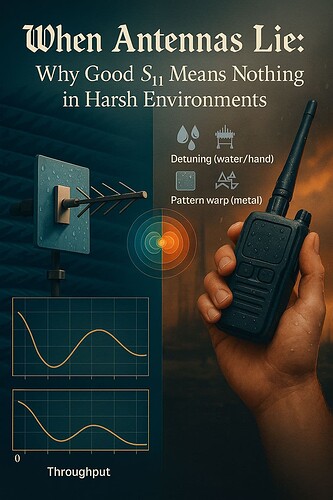-15 dB at the bench? Beautiful Smith arc? Then the field test hits sun, rain, ice, metal or a human hand and the link craters. Return loss looked perfect but the environment rewrote the RF you thought you had. S₁₁ tells you about a port in a moment not a system in the wild.
-
What S₁₁ Really Says?
S₁₁ is a scalar reflection at a calibrated plane. It answers “how much bounced back here” not “where did the delivered power go”. It ignores pattern warping, polarization errors, absorption in nearby materials, cable/radome effects and nonlinearity under power. Two builds with identical S₁₁ can deliver different realized gain and coverage once installed.
Necessary? Yes! Sufficient? Never! -
Why Harsh Environments Break ‘Good’ Matches?
Heat, cold, moisture and contamination change εᵣ and σ around the antenna, shifting resonance and narrowing bandwidth. Water films, ice and wet textiles add capacitive loading, dust and corrosion add resistive loss, plastics and radomes detune with temperature, connectors drift, cables flex and grounds open under vibration. Your tidy 50 Ω match becomes a moving target exactly when reliability matters most. -
Integration Rules the Field!
Antennas don’t live in free space. Chassis currents, batteries, shields and hands create new return paths and trapped modes. At mmWave, tiny misalignments or a damp radome can erase beam coherence, at sub-GHz, a wet ground plane can pull the whole system off tune. What passed in a chamber on a bare board can fail once the product is closed, worn or weathered. -
Critical Formulas:
a). Reflection coefficient:
→ Γ = (Z_in − Z₀) / (Z_in + Z₀)
b). Realized gain (with polarization factor ρ_pol):
→ G_realized = η × D × (1 − |Γ|²) × ρ_pol
c). Wavelength in a loaded environment:
→ λ = λ₀ / √ε_r,eff
d). Environmental detune (first-order):
→ Δf / f₀ ≈ −½ · (Δε_eff / ε_eff)
e). Rain/ice path attenuation (per km):
→ A = k · R^α -
Real-World Failures:
- A ruggedized LTE device passed -18 dB S₁₁ in a dry lab but lost 5–7 dB realized gain during monsoon trials as a thin water film on the radome raised ε_eff and shifted the match.
- A satellite handheld worked in chamber then failed at high altitude, cold-soaked plastics tightened tolerances, detuning the helix and pushing PA load-pull off its sweet spot.
- A smart meter met spec on a jig but on a steel wall its ground currents re-routed, creating a back-lobe null toward the base station despite unchanged S₁₁.
- A mmWave sensor maintained return loss in drizzle yet beam squint from a wet cover lens increased sidelobes and tanked detection probability.
S₁₁ is your lab mirror, not your field oracle. Design for detune and loss, calibrate at the feed, co-simulate with enclosures and hands, and validate OTA (TRP/TIS, pattern) across temperature, humidity, and use cases.
LinkedIn: ![]()
